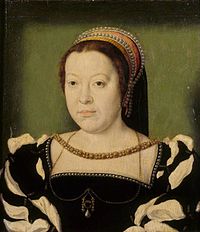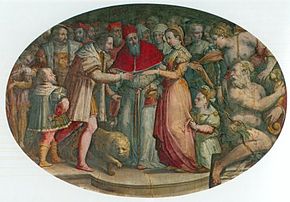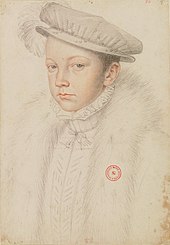Caterina de 'Medici
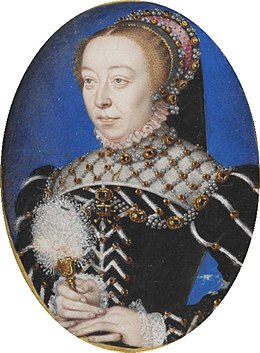
Caterina Maria Romula de 'Medici ( French Catherine de Médicis , German Katharina von Medici , born April 13, 1519 in Florence , † January 5, 1589 in Blois ) was Princess of Urbino and came from the influential Florentine Medici family . By marrying Henry II , she was Queen of France from 1547 , and later also regent for her underage sons.
family
Caterina de 'Medici came from the Florentine Medici family , who ruled Florence from 1434 to 1737 with two interruptions in the years 1494-1512 and 1527-1530. She was born on April 13, 1519 in Florence as the daughter of Lorenzo di Piero de 'Medici (1492-1519) and the French Bourbon princess Madeleine de la Tour d'Auvergne (1495-1519). The marriage between the French aristocracy and the descendants of an Italian family, which many in France regarded only as a wealthy merchant family, was at the instigation of the French King Francis I and Pope Clement VII , an uncle of Lorenzo, who belongs to the Medici family di Piero, came about. Francis I claimed several Italian principalities, including the Duchy of Milan , but needed a strong ally to enforce these claims. The marriage should consolidate the alliance with the Pope.
childhood
The Pope's relative

Caterina was born on April 13, 1519 in the Medici Palace in Florence, the only daughter of Duke Lorenzo von Urbino of the Medici family and his wife Madeleine de la Tour d'Auvergne. Caterina's mother died only 15 days after the daughter was born on April 28, 1519 as a result of the difficult delivery. Her father, who from today's point of view probably suffered from syphilis and tuberculosis , succumbed to his serious illness only a few days later on May 4, 1519. After the death of Caterina's father, her great-uncle, Pope Leo X , took over the guardianship of his young niece.
Franz I wanted the orphan - a very wealthy heiress thanks to her mother - to grow up at the French court. Leo X, however, did not follow this request, but had the infant brought from Florence to Rome , appointed her Duchess of Urbino and planned to later marry her to the son of his brother Giuliano de 'Medici , Ippolito de' Medici , who also died at an early age . However, Leo X died on December 1, 1521. In the conclave that followed his death, Hadrian VI was surprisingly . elected as the new Pope. Cardinal Giulio de 'Medici , a cousin of the late Medici Pope, who up to this point had great influence in the Vatican and had calculated chances of succeeding the Pope, then withdrew to Florence. Caterina de 'Medici was brought back to her native city in his wake.
Pope Hadrian VI died after only two years in office and on November 19, 1523, almost two months after Hadrian's death, Giulio de 'Medici was elected as the new Pope. As Pope Clement VII he ruled until 1534. Caterina was one of the richest girls in Europe not only because of her mother's inheritance, but also because of her relationship to the Pope, who was a son of her great-grandfather's brother, an interesting candidate for European marriage Princely courts. Clement VII had her raised in one of the Medici palaces in Florence under the care of her aunt Clarice Strozzi .
Hostage of the city of Florence
In 1526 Clement VII entered into an alliance with France, Venice , Florence and England in order to limit the influence of Emperor Charles V in Italy. In the following military conflicts, however, the troops of the alliance were defeated. On May 6, 1527 imperial troops invaded in Rome, sacked the so-called sack of Rome the city and laid siege to the Castel Sant'Angelo (Castel Sant'Angelo), in which the Pope had fled.
The defeat that Clement VII suffered in Rome also led to unrest in Florence and a republican interlude in the city, which had previously been under the influence of the Medici family. Eight-year-old Caterina de 'Medici, now a precious hostage of the Republic of Florence, was first held in the Convent of Santa Lucia and then in the Convent of Santa Caterina da Siena. On the intervention of the French ambassador , who found her living conditions in the convent of Santa Caterina da Siena as unworthy, Caterina was brought to the noble convent of Santa Maria Annunziata delle Murate on December 7, 1527. In the convent, actually mainly a retreat for widowed and wealthy noble ladies, young girls from noble houses were also brought up. In the past, the convent had received financial support from the Medici family and the abbess was Caterina's godmother. The girl was received in a friendly manner and was assigned a large and comfortably furnished monastery cell. She stayed there for the next three years. Her biographer Leonie Frieda attributes her good manners , her confident and engaging demeanor and her familiarity with the rites and traditions of the Catholic Church to these three years in the convent. The formal upbringing of Caterina de 'Medici is largely unknown. What is certain is that she learned Greek , Latin and French and was interested in mathematics.
On June 29, 1529, Clement VII and Charles V signed a peace treaty. Clemens promised Charles V the coronation as emperor. Charles V wanted to support Clemens in return for bringing the Medici back to power in Florence. Clemens 'illegitimate son Alessandro de' Medici was also to be married to Karl's illegitimate daughter Margaret of Austria . As early as October 1529, the siege of the city of Florence by imperial troops began to bring the Medici family back to power there. While the plague and famine claimed victims in the besieged city, the government in Florence also discussed what should happen to the now eleven-year-old Caterina. One of the seriously discussed proposals was to let her down naked in a basket from the city walls so that she might perish in the cannon fire of the imperial troops. It was also considered to let her work as a prostitute in one of the brothels in order to destroy all further marriage plans that Clement VII might have for her. The only decision was, however, to return them to the Santa Lucia convent, where they were believed to be more secure. When a small republican troop came on July 20, 1530 to pick up Caterina from the convent Maria Annunziata delle Murate, the young girl was convinced that they wanted to lead her to her execution. In preparation for this, she had shaved her hair and put on a nun's robe. Riding a donkey, she was taken through the narrow streets to the convent of Santa Lucia amid screams and threats from the starving Florentine population.
Papal candidate for marriage
The siege of Florence ended on August 12, 1530; Clement VII took possession of the city again. Caterina de 'Medici returned to the papal court in Rome, where she lived with her great-aunt Lucrezia Salviati , a sister of Leo X. She only returned to Florence on the occasion of the enthronement of Clement VII's illegitimate son Alessandro in 1532 as Duke of Florence. It was the first time in her life that she performed representative duties.
Meanwhile, Clement VII forged marriage plans for Caterina in Rome. Ippolito de 'Medici, whom Pope Leo X had once designated as her husband, had been appointed cardinal by Clement VII and had been the papal legate in Hungary since 1532 . Several Italian princes had already applied for Caterina's hand; The illegitimate son of Henry VIII , the Duke of Richmond , had also been discussed as a candidate for marriage . The Scottish King James V was also considered. Emperor Charles V wanted a marriage between Caterina and Francesco II Sforza , the Duke of Milan. For Clement VII this would have meant a very close bond with the emperor after the marriage of their two illegitimate children. It was therefore more opportune to him that the French King Francis I proposed, as early as 1531, to marry his second-born son Heinrich, the Duke of Orléans, to Caterina. His older brother, the heir to the French throne, was still alive; otherwise the idea of marrying the “Italian grocer's daughter” would hardly have occurred, regardless of how rich her dowry or inheritance was.
Franz I wanted his presumptive daughter-in-law to spend the time leading up to the wedding at the French court. Clement VII, however, did not allow this; he feared the wrath of the emperor who fought with Franz for supremacy in Italy and for whom the marriage of the Medici daughter to Heinrich von Orléans represented a defeat. To deceive Charles V, the Pope even continued his negotiation with the Duke of Milan about a wedding with Caterina de 'Medici. Charles V received rumors that a marriage with the French royal family was imminent, but he considered this unimaginable in view of the descent of Caterina.
Wedding with Heinrich von Orléans
The wedding between Henry of Orléans and Caterina de 'Medici took place in October 1533 in Marseille . Caterina was only 14 years old, her groom only 14 days older than her. Clement VII had his young relatives abundantly furnished: he commissioned Isabella d'Este , who was famous for her taste, to choose the clothes that Caterina was to take with her to the French royal court. The jewelry he gave to his relatives was also extensive. A large pair of earrings made from unusually large, pear-shaped pearls was particularly famous. Caterina later gave it to her daughter-in-law Maria Stuart . She took them back to Scotland after her widowhood, and Elizabeth I wore these earrings after her execution .
A fleet of more than forty ships brought Caterina to Marseille . She was accompanied not only by Pope Clement VII and 13 cardinals, but also by a large group of bishops and members of the papal court. A wooden palace had been built in Marseilles to receive Caterina and her companions. The French King Francis I, the bridegroom Henry of Orléans and the French retinue lived in the palace of the Comte de Provence on the Place Neuve. A large chamber was built between the palace of the Comte de Provence and the wooden palace for the Italian wedding party to enable encounters between the Pope and the French king unobserved by outsiders.
On October 12, 1533, a Sunday, Clement VII first entered the city with a solemn ceremony. On October 13, 1533, King Francis I and his second-born son moved in, accompanied by 200 soldiers, 300 archers and the velvet- clad Swiss bodyguard of the French king. For ten days they negotiated the final details of the marriage contract , which granted Francis I above all territorial claims in Italy. A handwritten note has been preserved from these negotiations, which states, among other things, that papal and French troops wanted to retake Milan and that Henry of Orléans would rule there in the future. Parma and Piacenza should be placed under French rule by the Pope and Urbino should be retaken.
On October 23, 1533, after the negotiations between the Pope and the French King had been concluded, the bride finally entered Marseille. The marriage contract was signed on October 27, 1533, and the church wedding took place on October 28, 1533. After a masked ball, the two fourteen-year-olds were led into the wedding chamber. Clemens blessed the couple the next morning and was pleased that he found the two of them still in bed.
Years of marriage
The Italian mesalliance

Clement VII died on September 25, 1534. The territorial promises he had made to Francis I had so far remained unfulfilled and Caterina's dowry had only been partially paid. Paul III , who succeeded Clement VII on the papal throne , refused to fulfill the territorial promises of his predecessor to the French king; he also refused to pay Caterina's outstanding dowry. The marriage of the second-born son to Caterina de 'Medici had lost its political value for the French court with the death of Clement VII. In view of their lack of connection to other European royal houses, voices rose in France that viewed the marriage as a mesalliance or a political mistake.
Caterina de 'Medici would have been largely isolated at the French court had she not won a place in the closer society around her father-in-law. With her slightly protruding eyes and her bulky figure, she was not considered pretty, but she was socially agile, a trained and courageous rider , a witty and engaging conversationalist and ready to share the sometimes rough jokes that the French king valued. With the side saddle , which she popularized in France, she was able to keep up with the hunts on horseback, and thus earned her royal father-in-law's esteem. Politically, she was smart enough to treat the king's official mistress , Anne de Pisseleu , the Duchess of Étampes, with the greatest respect and to develop a friendly relationship with her. Similarly, she knew how to make herself popular with Margaret of Navarre , the king's sister. On the other hand, she was unable to conquer her husband - his connection with Diana of Poitiers grew closer and closer, while he reacted with displeasure to the close relationship between his wife and the royal mistress, who was fighting with his lover for influence at the French royal court.
On the morning of August 10, 1536, the French heir to the throne died unexpectedly after a brief, severe illness. Heinrich, Caterina's husband, was now the new contender for the French royal crown. This made her situation worse; she had been married for three years without the slightest sign of pregnancy. After Heinrich had also become the father of an illegitimate daughter in 1538, everyone at the French royal court suspected her to be the reason why there had been no children so far. There were increasing considerations about divorce due to childlessness.
Of all people, Diane de Poitiers, Heinrich's mistress, was one of the partisans at the French royal court who advocated a continuation of the marriage. A new, younger bride might have undermined her position. She convinced Heinrich, who had a distant relationship with his father, to continue the marriage, pointing out that it was mainly his father's partisans who advocated a divorce. The final decision about a divorce, however, lay with Franz I .:
“Katharina risked everything in an incomparable show of female submission to the man who described himself as the greatest gentleman in France. While she threw herself sobbing at his feet, Katharina declared that she would of course step aside for Heinrich's new bride who could bear children for him. She herself only asked to be allowed to stay in France and to be allowed to serve the happy woman, no matter what position the king assigned her. ""
The public humiliation to which Caterina submitted in front of the eyes of the French royal court touched the French king so much that he spoke out in favor of a continuation of the marriage, pointing out that it was God's will that she should be his daughter-in-law and Henry's wife. The king's declaration strengthened Caterina's position at court. Margaret of Navarre , the king's sister, reminded her nephew of the qualities of his wife several times in letters. Diane de Poitiers sent Caterina drugs to increase her fertility and made sure that Heinrich had regular sexual intercourse with his young wife. At the same time, Caterina de 'Medici underwent all sorts of medical procedures in order to finally get pregnant. Even so, it was not until 1543 that a pregnancy was determined. On January 19, in the presence of the French king, she finally gave birth to her first son, named after her father-in-law Franz. Over the next twelve years, nine more children followed, six of whom survived childhood. Due to the many pregnancies, Caterina de 'Medici appeared matronly from an early age.
Queen of France
With the birth of her first son, Caterina's position at the French court changed significantly. For the first time she had a central role at the royal court. However, the close bond between Heinrich and his mistress Diane de Poitiers remained, who was not only present during the birth of the first son, like King Francis I, but also interfered in the upbringing of the children. However, the conflicts between the mistress of the French king, Anne de Pisseleu, and Diane de Poitiers escalated, in which the mistress prevailed and the mistress was banned from the French royal court for more than a year.
On March 31, 1547, King Franz I died, Caterina's husband Heinrich succeeded him to the throne and was anointed King Henry II on July 25, 1547 in Reims. This made Caterina Queen of France. Henry II continued to be strongly influenced by his mistress, Diane de Poitiers. Caterina was able to come to terms with this situation. When Heinrich II died unexpectedly in 1559, Caterina was completely inexperienced in government affairs.
Caterina during the reign of her son Francis II (1559–1560)
During the barely one and a half year reign of her son Franz II (1544-1560), Caterina only played a subordinate role. His wife was Maria Stuart (1542–1587), Queen of Scotland, also a Catholic candidate for the English royal crown. Politics was determined by their uncle, Cardinal Charles de Guise and Duke Franz von Guise . Caterina de 'Medici cautiously strengthened the moderate party of the so-called Politiques by enforcing the appointment of Michel de l'Hôpital as Chancellor in April 1560 . Franz II died on December 5, 1560 at the age of 16 from the effects of an ear infection.
Caterina during the reign of her son Charles IX. (1560–1574)
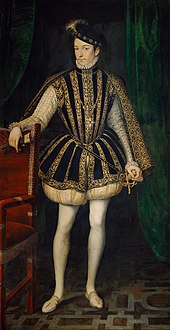
While Franz II was of legal age, Charles IX was 10 years old at the time . a reign is inevitable. The Guise were out of the question for this because they were not members of the royal family. Caterina de 'Medici won the reign without a fight, as she included the alternative candidates from the House of Bourbon in the reign. Duke Franz von Guise was involved in the massacre of Wassy in 1562 , which triggered the Huguenot Wars of 1562–1598. Franz von Guise was murdered in 1563 by a Huguenot in the vicinity of the Huguenot leader Admiral Coligny .
The first three Huguenot Wars 1562–1563, 1567–1568 and 1568–1570 were relatively harmless and consisted of small skirmishes and long tough negotiations with the arguing aristocratic groups that Caterina led on behalf of her son. Then she lost control of her son to the Huguenot leader Admiral Coligny. This favored an anti-Spanish policy, which seemed promising because of the Dutch struggle for freedom (from 1568) and potentially France could one behind the king. Such a course naturally required the reconciliation of Huguenots and Catholics within France. This reconciliation was to be sealed with the marriage of Caterina's daughter Margarete to the young Huguenot leader Heinrich von Navarra . However, the wedding feast turned into a massacre of the Huguenots, the so-called Bartholomew Night, and the Fourth Huguenot War 1572–1573, which almost led to the destruction of the Huguenots. Only the choice of the later Heinrich III. to the Polish king prevented their complete annihilation: the Poles had to be presented with a country in which freedom of belief was valid. Caterina de 'Medici was already regarded by contemporaries as the mastermind behind the Bartholomew Night. Charles IX died of tuberculosis on May 30, 1574 at the age of 23 .
Caterina during the reign of her son Heinrich III. (1574–1589)
Henry III. preferred the French throne over the Polish throne. Caterina's position was now more delicate than ever: the son was of legal age, but did not rule from her point of view. Also from the perspective of her son Heinrich III. The situation was delicate: as a king of legal age, he was not allowed to give the impression of being under his mother's thumb. On the other hand, his mother was probably the only person whose good intentions he could fully trust: on the return trip from Poland to France to take over rule, he was able to visit Venice without worries because the loyal mother held the position in France. As a rule, Heinrich III. his mother acted independently, but gave neither negotiating instructions nor powers of attorney and was able to leave his mother out in the rain: Caterina's negotiating marathons from 1576 with her son-in-law Heinrich von Navarra, who had risen to become Huguenot leader, contributed significantly to the Huguenot Wars of 1575–1576, 1576–1578 , 1579–1580 were relatively harmless. Particularly in 1576, when the politically dissatisfied rallied around the heir to the throne Franz , Caterina's youngest son, Caterina crushed the overwhelming opposition in negotiations with her son Franz: Franz was initially satisfied with a generous apanage.

Franz could still hope to become king, since his older brother had only been the father of one legitimate daughter and illegitimate sons. But with astonishing support from his royal brother, Franz strove for his own Protestant kingdom: either by marrying the much older Queen Elizabeth of England or as the chosen sovereign of the rebellious United Netherlands . Unlike her sons, Caterina feared the power of Spain and was at least able to ensure that France officially had nothing to do with the activities of her youngest son. Franz failed because of his own incompetence and died in 1584. The Huguenot Henry of Navarre became the French heir to the throne. This led to the renewal of the Catholic League by Duke Henry I of Guise , who did not shy away from an alliance with Spain, to the disempowerment of their royal son in 1584 and to the Eighth Huguenot War 1585–1598. Despite his disempowerment, Heinrich III. to flee from the rebellious mob from Paris, for which he blamed the Guise. Shortly before Caterina's death on January 5, 1589, Heinrich III. murdered Duke Heinrich I von Guise and his brother in December 1588 without consulting their mother. Caterina did not live to see the murder of her son in August 1589 and the end of the Valois, which led to the coronation of Henry of Navarre as King of France.
Caterina de 'Medici died in the royal castle of Blois . She was buried in the Saint-Denis basilica . When the royal tombs of Saint-Denis were sacked during the French Revolution , their grave was opened and looted on October 18, 1793, and their remains were buried in a mass grave outside the church. During the Bourbon restoration after 1815, the bones and mortal remains buried in the two pits outside the cathedral were recovered and, since they could no longer be assigned to individual individuals, were buried in a shared ossuary in a crypt of the cathedral.
Cultural influence
The connection to the Italian Medici dynasty meant that a number of Italian customs, ways of life and everyday objects found their way into the French court. The introduction of the side saddle in France is commonly traced back to Caterina de 'Medici, who first allowed her to take part in the hunts on horseback that her father-in-law enjoyed so much. Up until this point in time, women in France used a chair-like litter attached to the side, which offered them little support and, at best, allowed the slow gallop of a regularly walking horse. She was also probably one of the first women in France to wear a simple form of underpants under her lavish wardrobe.
Caterina had a lasting influence on French cuisine , she is considered the mother of French culinary art. Up until then this was rather hearty and rustic, the Italian cooks she brought to the French court opened up previously completely unknown delights to the French nobility. Fine dining with select ingredients and elaborate preparation subsequently became a status symbol . Caterina also had a lasting influence on improving table manners; so it should not have been unusual before her time at the French court to blow her nose on the tablecloth.
In addition, she is said to have made the snuff acceptable.
progeny
From Caterina's marriage to Henry II, ten children were born, three of whom died as infants. The three last French Valois kings Franz II. , Karl IX. and Heinrich III. were sons of Caterina.
- Francis II (January 19, 1544 - December 5, 1560), married to Maria Stuart , Queen of Scotland (1558–1560) and of France (1559–1560)
- Elisabeth (April 2, 1545 - October 3, 1568), married to Philip II , King of Spain
- Claudia (* November 12, 1547 - February 21, 1575), married to Duke Charles III. of Lorraine
- Ludwig (February 3, 1549 - October 24, 1549)
- Charles IX (June 27, 1550 - May 30, 1574), King of France (1560–1574)
- Henry III. (September 19, 1551 - August 2, 1589), King of France (1574–1589)
- Margarete (14 May 1553 - 27 March 1615), married in 1572 to Henry IV , King of France
- Hercule, named Franz after the death of his eldest brother (* March 18, 1555, † June 10, 1584)
- Johanna (June 24, 1556 - June 24, 1556)
- Victoria (June 24, 1556 - August 17, 1556)
Her eldest daughter Elisabeth was married to the Spanish King Philip II and her youngest surviving daughter Margarete married the Protestant Henry of Navarre, later King Henry IV. During the wedding celebrations in August 1572, a massacre of Protestant nobles took place, which is recorded in history is called Bartholomew's Night and for which then (and often still today) Caterina de 'Medici, who was defamed as a foreigner, is held responsible. In fact, Caterina tried several times through often tough rounds of negotiations with the militarized French nobility to limit the extent of the French civil wars.
Only her daughter Margarete - also known as Margot - inherited the robust physical constitution of her mother. The rest of her children were susceptible to infection throughout their lives and occasionally showed signs of mental confusion in adulthood. Some historians see it as a sign of inherited syphilis. The unstable health of her sons in particular ensured that Caterina de 'Medici played a central role in the government of France for much of her life.
Since none of their sons had a legitimate male descendant, the French crown fell in 1589 to the leader of the French Protestants , Henry of Navarre from the Bourbon branch line, who was able to win the crown by converting to Catholicism and was named King Henry IV from 1589 to 1610 . ruled.
literature
- Sabine Appel : Catherine of Medici. Strategist of power and pioneer of modern times. Klett-Cotta, Stuttgart 2018, ISBN 978-3-608-96198-0 .
- Denis Crouzet : Le haut coeur de Catherine de Médicis. Une raison politique aux temps de la Saint-Barthélemy (= Bibliothèque Albin Michel Histoire ). Albin Michel, Paris 2005, ISBN 2-226-15882-0 .
- Leonie Frieda: Catherine de Medici. Phoenix, London 2005, ISBN 0-7538-2039-0 .
- Janine Garrisson : Catherine de Médicis. L'impossible harmonie (= Collection portraits intimes ). Payot Rivages, Paris 2002, ISBN 2-228-89657-8 .
- Sabine Frommel, Gerhard Wolf (ed.): Il mecenatismo di Caterina de 'Medici. Poesia, festivals, musica, pittura, scultura, architettura (= Institute for Art History in Florence, Max Planck Institute. Studi e ricerche. Vol. 2). Marsilio, Venice 2008, ISBN 978-88-317-9352-0 .
- Jean-Hippolyte Mariéjol: Catherine de Médicis (= biography ). Tallandier, Paris 2005, ISBN 2-84734-226-5 .
- Jean-François Solnon : Catherine de Médicis. Perrin, Paris 2003, ISBN 2-262-01834-0 .
- Thierry Wanegffelen: Catherine de Médicis. Le pouvoir au féminin (= biography of Payot ). Payot, Paris 2005, ISBN 2-228-90018-4 .
Web links
- Literature by and about Caterina de 'Medici in the catalog of the German National Library
- Portraits of Caterina de 'Medici (French)
- Spektrum .de: To dance to the blood wedding April 13, 2019
Remarks
- ↑ Katharina von Medici, the mother of French culinary art ( Memento from January 7, 2012 in the Internet Archive )
| predecessor | Office | Successor |
|---|---|---|
| Eleanor of Castile |
Queen of France 1547–1559 |
Maria Stuart |
| personal data | |
|---|---|
| SURNAME | Medici, Caterina de ' |
| ALTERNATIVE NAMES | Medici, Caterina Maria Romula de '; Médicis, Catherine de |
| BRIEF DESCRIPTION | Princess of Urbino, Queen of France by marriage |
| DATE OF BIRTH | April 13, 1519 |
| PLACE OF BIRTH | Florence |
| DATE OF DEATH | January 5, 1589 |
| Place of death | Blois |
